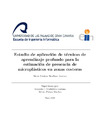Please use this identifier to cite or link to this item:
https://accedacris.ulpgc.es/handle/10553/77897
| DC Field | Value | Language |
|---|---|---|
| dc.contributor.advisor | Castrillón Santana, Modesto Fernando | es |
| dc.contributor.advisor | Peñate Sánchez, Adrián | es |
| dc.contributor.author | Benlliure Jiménez, Maria Cristina | es |
| dc.date.accessioned | 2021-03-02T15:08:26Z | - |
| dc.date.available | 2021-03-02T15:08:26Z | - |
| dc.date.issued | 2020 | - |
| dc.identifier.uri | https://accedacris.ulpgc.es/handle/10553/77897 | - |
| dc.description.abstract | La presencia de microplásticos en el mar es un problema que ha adquirido relevancia en los últimos tiempos. Para analizar su evolución se llevan los residuos plásticos de zonas costeras a laboratorios para su conteo exhaustivo. Debido a la complejidad de recopilación de muestras y tratamiento de datos es fundamental tanto la eficiencia como la estandarización durante el proceso. El objetivo de este estudio es determinar la integración de herramientas automáticas, permitiendo acelerar su observación. Para ello se utilizaron imágenes capturadas directamente en la playa. En el documento se comparan los resultados obtenidos tanto en la detección como en la estimación de plásticos, entre distintas arquitecturas de redes neuronales artificiales. | en_US |
| dc.description.abstract | Recently, the presence of micro-plastics at sea is an issue that has gained prominence. To analyze its evolution, plastic waste from seaside is taken to laboratories for its exhaustive counting. Due to the complexity of sample collection and data processing, efficiency and standardization are essential during the process. The objective of this study is to determine the integration of automatic tools to accelerate its analysis. For this, images captured directly on the beach were used. This document compares the results obtained in the detection of plastics as well as estimation of plastics, between different architectures of artificial neural networks. | en_US |
| dc.language | spa | en_US |
| dc.subject | 120317 Informática | en_US |
| dc.subject.other | Microplásticos | es |
| dc.subject.other | Aprendizaje profundo | es |
| dc.subject.other | Redes neuronales | es |
| dc.subject.other | Inteligencia artificial | es |
| dc.subject.other | Microplastics | es |
| dc.subject.other | Deep learning | es |
| dc.subject.other | Machine learning | es |
| dc.subject.other | Artificial intelligence | es |
| dc.title | Estudio de aplicación de técnicas de aprendizaje profundo para la estimación de presencia de microplásticos en zonas costeras | es |
| dc.title.alternative | Study of deep learning techniques for the detection of microplastics in seaside | en_US |
| dc.type | info:eu-repo/semantics/bachelorThesis | en_US |
| dc.type | BachelorThesis | en_US |
| dc.contributor.departamento | Departamento de Informática y Sistemas | es |
| dc.contributor.facultad | Escuela de Ingeniería Informática | en_US |
| dc.identifier.absysnet | 771883 | - |
| dc.investigacion | Ingeniería y Arquitectura | en_US |
| dc.type2 | Trabajo final de grado | en_US |
| dc.utils.revision | Sí | en_US |
| dc.identifier.matricula | TFT-56306 | es |
| dc.identifier.ulpgc | Sí | en_US |
| dc.contributor.buulpgc | BU-INF | es |
| dc.contributor.titulacion | Grado en Ingeniería Informática | es |
| item.grantfulltext | open | - |
| item.fulltext | Con texto completo | - |
| crisitem.advisor.dept | GIR SIANI: Inteligencia Artificial, Robótica y Oceanografía Computacional | - |
| crisitem.advisor.dept | IU Sistemas Inteligentes y Aplicaciones Numéricas | - |
| crisitem.advisor.dept | Departamento de Informática y Sistemas | - |
| crisitem.advisor.dept | GIR SIANI: Inteligencia Artificial, Redes Neuronales, Aprendizaje Automático e Ingeniería de Datos | - |
| crisitem.advisor.dept | IU Sistemas Inteligentes y Aplicaciones Numéricas | - |
| crisitem.advisor.dept | Departamento de Informática y Sistemas | - |
| Appears in Collections: | Trabajo final de grado | |
Page view(s)
349
checked on May 18, 2024
Download(s)
341
checked on May 18, 2024
Google ScholarTM
Check
Share
Export metadata
Items in accedaCRIS are protected by copyright, with all rights reserved, unless otherwise indicated.
